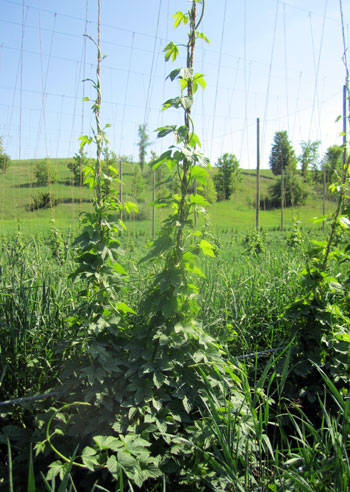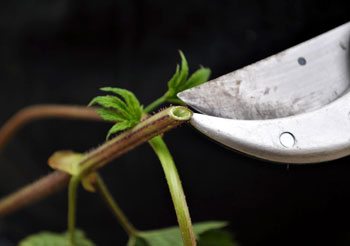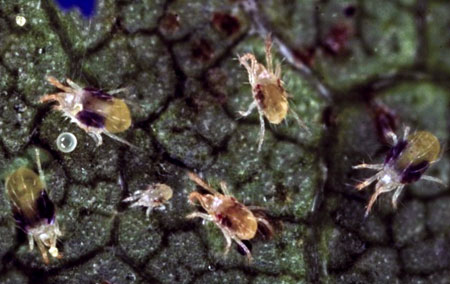Michigan hops update – May 31, 2013
Growers should begin scouting for two-spotted spider mites and potato leafhoppers this week. MSU Extension will be tracking hop development this season and providing growers with relevant pest management information.
Hop bines around Michigan are really taking off with the ample rain and some warmer weather. Bines vary in height, but average 5 feet in northwest Michigan this week. Growing degree day (GDD) accumulation is significantly different along the western portion of the state where the majority of hop acreage is located. So far this season the Benton Harbor Enviro-weather station has accumulated 419 GDD50 with 0.69 inches rain over the past week, the Clarksville Enviro-weather station has recorded 406 GDD50 with 2.31 inches rain and the Northwest Michigan Horticultural Research Center accumulated 323 GDD50 with just under 0.75 inches of rain last week. Some planting, pruning of bull shoots and training is still underway in northwest Michigan.

Photo 1 shows hop development in northwest
Michigan on May 31, 2013. Photo credit: Erin Lizotte.

Photo 2 shows a hollow bull shoot. Keep in mind that these largest bines that emerge on plants (second leaf or older) are not necessarily the best to train. Their hollow center makes them more susceptible to wind damage and they are more brittle and less succulent. Most crowns produce two to three bull shoots that often differ in color, have larger spaces between internodes and are more fibrous than other bines. Photo credit: Brian Gaideski.
With significant leaf tissue present, many growers have begun to scout for mites. Two-spotted spider mites are a significant pest of hops in Michigan and can cause complete economic crop loss when high numbers occur by decreasing the photosynthetic ability of the leaves and causing direct mechanical damage to the hop cones. Two-spotted spider mites feed on the liquid in plant cells, eventually causing visible symptoms. Leaves take on a white appearance and will eventually defoliate under high pressure conditions. Intense infestations weaken the plant and reduce yield and quality. Infested cones develop a reddish discoloration, do not hold up to the drying process and commonly have lower alpha levels and shorter storage potential. Additionally, the mites themselves act as a contaminate issue for brewers.
In the spring, only female two-spotted spider mites are present as they have overwintered in a dormant stage from the previous season and are already mated and ready to lay fertilized eggs. She appears particularly orange in color this time of the year and has overwintered on debris and trellis structures in the hop yard. As temperature warms, the females feed and begin laying eggs. Larvae emerge from the eggs in two to five days – depending on temperatures – and develop into adults in one to three weeks – again, depending on temperature. Two-spotted spider mites like it hot with the pace of development increasing until an upper threshold around 100 degrees Fahrenheit is reached. Conversely, cold and wet weather is not conducive to development.
Two-spotted spider mites are very small, but can be observed on the underside of leaves using a hand lens. As the season progresses, cast skins and old webbing give infested leaves a dusty and dirty appearance. The eggs look like tiny clear spheres and are most commonly found in close proximity to adults and larvae. The larvae themselves are small, translucent versions of the adults that begin the season with a distinctly orange hue that changes over to translucent, yellow or green as they feed. Adults also have two dark spots.

Photo 3 shows two-spotted spider mite eggs, larvae and adults
(the adult females are the largest followed by the males).
Photo credit: David Cappaert, MSU
When you are observing the underside of leaves, keep an eye out for beneficial, predatory mites that actually feed on two-spotted spider mites. Predatory mites are often translucent, larger than two-spotted spider mites and move at a much faster speed across the leaf surface. Predatory mites play an important role in balancing the two-spotted spider mite population and should be protected when possible.
Growers should be scouting for mites now and remember that only when mites reach an economically significant level should cultural and chemical intervention be considered. Scouts should take leaf samples from 3 to 6 feet up the bine; as the season progresses, samples should be taken from higher on the bine as the mites migrate upward. Use a hand lens to evaluate two leaves from 20 plants per yard. Thresholds developed in the Pacific Northwest have established that more than two adult mites per leaf in June indicate the need to implement a pest management strategy. By mid-July, the threshold increases to five to 10 mites per leaf. Remember that if cones are not infested, hop plants can tolerate a good deal of damage from mites.
There are many factors that can affect the prevalence of mites in a given season, including the presence of beneficials, rainfall and temperatures. Consider selecting insecticides that have a minimal effect on beneficial insect populations and do not apply pesticides for mite control unless absolutely necessary as one application often necessitates continual applications in the absence of beneficial predators. Specifically, pyrethroid applications have been shown to increase mite populations in the hopyard due to their negative impact on beneficial insects
Some growers have reported applying protectant fungicides for mildew prevention. According to Michigan State University Extension, Michigan growers have yet to report significant mildew damage, but given the experiences of hop growers around the United States, it is likely that mildew will become an issue in Michigan. With the heavy rainfall and saturated soils in many areas of the state, growers who typically fertigate are considering alternate means of delivering nutrients.
Growers should also be on the lookout for potato leafhoppers this week as storm systems move through, likely carrying adults from the Gulf Region. Check back next week for more information on how to scout and manage for leafhoppers.



 Print
Print Email
Email

